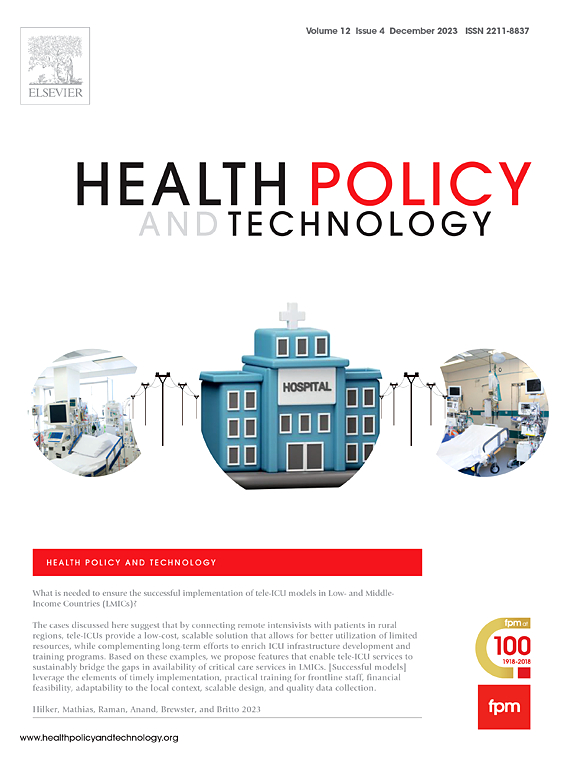A scoping review of modelling in target product profile development for medical innovation
IF 3.7
3区 医学
Q1 HEALTH POLICY & SERVICES
引用次数: 0
Abstract
Background
Target Product Profiles (TPPs) serve as strategic tools for planning medical innovation development, facilitating communication with regulators, and developing market access strategies. Modelling can assist TPPs development and provide guidance on defining attributes. This scoping review aims to outline the general steps in employing models in developing or refining TPPs and to identify the common themes of the attributes informed by modelling.
Methods
PRISMA-ScR checklist was used to guide this review. Literature search in PubMed, Scopus, Web of Science, Embase, and the World Health Organization Institutional Repository for Information Sharing (WHO IRIS) was conducted between August and September 2023. Subsequently, two researchers reviewed abstracts independently. Only full text articles used modelling to inform TPPs of health technologies with detailed modelling and methodology reported were included in this review. General information, technology-related information, TPP-related information, and model-related information were extracted from the articles and analysed thematically. EPIFORGE 2020 checklist was used to assess the reporting quality of modelling approach of the included articles.
Results
This review included 23 articles published from 2010 onward, reflecting a growing interest in using modelling to inform TPPs development. The studies covered diverse medical innovations, including drugs, vaccines, devices, procedures, and vector control tools. Commonly modelled attributes for devices included health impact, economic value, and efficacy. For non-device innovations, clinical efficacy, economic value, and dosage were the most frequently modelled attributes. The modelling process typically involved three steps: scoping, model development and validation, and analysis with recommendations. Limitations from the modelling process discussed across studies fell into three categories: evidence quality, modelling assumptions and structure, and the generalisability of findings. While some attributes, like clinical efficacy, are straightforward to model, certain attributes such as human factors require considering proxies such as compliance rates or capacity constraints.
Conclusions
This review identified common product attributes in TPPs that were informed by modelling, outlined the modelling process, and highlighted key limitations. It provided recommendations to improve the modelling approach in TPPs development and highlighted the need for further research to standardise the modelling process.
Public Interest Summary
Target Product Profiles (TPPs) are documents that outline targets for new medical innovations to effectively address specific public health needs. These documents are developed through multiple rounds of consultations with domain experts and stakeholders. We aimed to study how mathematical modelling can be used to support TPPs development. Through a systematic search, we identified and studied 23 papers that used modelling. We observed a structured three-step process: identifying the suitable model, testing and tuning the model, and using the model outputs to set the targets. Modelling was primarily applied to establish targets relating to efficacy and economic values of the medical innovations. Our findings offer insights into the role of modelling in TPPs development and inform potential future methodological guidance.
医学创新中目标产品概要开发建模的范围综述
目标产品简介(TPPs)是规划医疗创新发展、促进与监管机构沟通和制定市场准入战略的战略工具。建模可以帮助ppp开发,并为定义属性提供指导。这一范围审查的目的是概述在开发或改进TPPs中使用模型的一般步骤,并确定建模所告知的属性的共同主题。方法采用sprima - scr检查表进行评价。2023年8月至9月在PubMed、Scopus、Web of Science、Embase和世界卫生组织信息共享机构知识库(WHO IRIS)中进行文献检索。随后,两位研究人员独立审查了摘要。只有全文文章使用模型向TPPs介绍卫生技术,并报告了详细的模型和方法,才被纳入本综述。从文章中提取一般信息、技术相关信息、tpp相关信息和模型相关信息,并进行主题分析。使用EPIFORGE 2020检查表评估纳入文章的建模方法的报告质量。本综述纳入了2010年以来发表的23篇文章,反映了人们对使用模型为TPPs开发提供信息的兴趣日益浓厚。这些研究涵盖了各种医疗创新,包括药物、疫苗、设备、程序和病媒控制工具。设备的常用建模属性包括健康影响、经济价值和功效。对于非器械创新,临床疗效、经济价值和剂量是最常见的建模属性。建模过程通常包括三个步骤:确定范围、模型开发和验证,以及带建议的分析。研究中讨论的建模过程的局限性分为三类:证据质量、建模假设和结构以及研究结果的普遍性。虽然有些属性(如临床疗效)可以直接建模,但某些属性(如人为因素)需要考虑诸如依从率或容量限制等代理。本综述通过建模确定了tpp中常见的产品属性,概述了建模过程,并强调了关键的局限性。它提出了建议,以改进发展合作伙伴计划的建模方法,并强调需要进一步研究以使建模过程标准化。公共利益摘要目标产品概况(TPPs)是概述新的医疗创新目标的文件,以有效地满足特定的公共卫生需求。这些文件是通过与领域专家和利益相关者的多轮磋商制定的。我们的目标是研究如何使用数学建模来支持ppp的发展。通过系统搜索,我们确定并研究了23篇使用建模的论文。我们观察到一个结构化的三步过程:确定合适的模型,测试和调整模型,并使用模型输出来设置目标。建模主要用于建立与医疗创新的功效和经济价值有关的目标。我们的研究结果为建模在TPPs发展中的作用提供了见解,并为潜在的未来方法指导提供了信息。
本文章由计算机程序翻译,如有差异,请以英文原文为准。
求助全文
约1分钟内获得全文
求助全文
来源期刊

Health Policy and Technology
Medicine-Health Policy
CiteScore
9.20
自引率
3.30%
发文量
78
审稿时长
88 days
期刊介绍:
Health Policy and Technology (HPT), is the official journal of the Fellowship of Postgraduate Medicine (FPM), a cross-disciplinary journal, which focuses on past, present and future health policy and the role of technology in clinical and non-clinical national and international health environments.
HPT provides a further excellent way for the FPM to continue to make important national and international contributions to development of policy and practice within medicine and related disciplines. The aim of HPT is to publish relevant, timely and accessible articles and commentaries to support policy-makers, health professionals, health technology providers, patient groups and academia interested in health policy and technology.
Topics covered by HPT will include:
- Health technology, including drug discovery, diagnostics, medicines, devices, therapeutic delivery and eHealth systems
- Cross-national comparisons on health policy using evidence-based approaches
- National studies on health policy to determine the outcomes of technology-driven initiatives
- Cross-border eHealth including health tourism
- The digital divide in mobility, access and affordability of healthcare
- Health technology assessment (HTA) methods and tools for evaluating the effectiveness of clinical and non-clinical health technologies
- Health and eHealth indicators and benchmarks (measure/metrics) for understanding the adoption and diffusion of health technologies
- Health and eHealth models and frameworks to support policy-makers and other stakeholders in decision-making
- Stakeholder engagement with health technologies (clinical and patient/citizen buy-in)
- Regulation and health economics
 求助内容:
求助内容: 应助结果提醒方式:
应助结果提醒方式:


